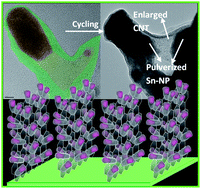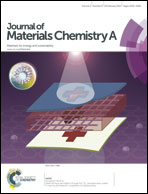Self-assembled growth of Sn@CNTs on vertically aligned graphene for binder-free high Li-storage and excellent stability
Abstract
Although widely used, the current Li-ion battery (LIB) technology still suffers from a lack of suitable electrodes with enhanced energy and power density, cycling stability, energy efficiency and cycling life. As an anode material for LIBs, metallic tin (Sn) has attracted tremendous interest, owing to its high theoretical capacity. Nevertheless, the practical implementation of metallic tin to LIBs is greatly hampered by the poor cyclability, because volume changes that occur during charging and discharging, result in both mechanical failure and loss of electrical contact at the electrode and the tin nanoparticle aggregates during the discharging process. Here, we report for the first time, a new strategy to grow self-assembled Sn@CNT on vertically aligned graphene (VAGN) by the microwave plasma irradiation reduction of SnO2 growth on VAGN and in situ encapsulating all the Sn nanoparticles in CNTs. The composite, as an anode material in lithium ion batteries, exhibits a high reversible capacity of 1026 mA h g−1 at 0.25 C (cycle lives of more than 280 times) and a capacity of 140 mA h g−1 is retained in a discharge time of 12 s, which represents the best performance values attained for a Sn anode to date. We expect the proposed route to be adopted by the rapidly growing energy storage research community.

- This article is part of the themed collection: 2014 Journal of Materials Chemistry A Hot Articles

 Please wait while we load your content...
Please wait while we load your content...